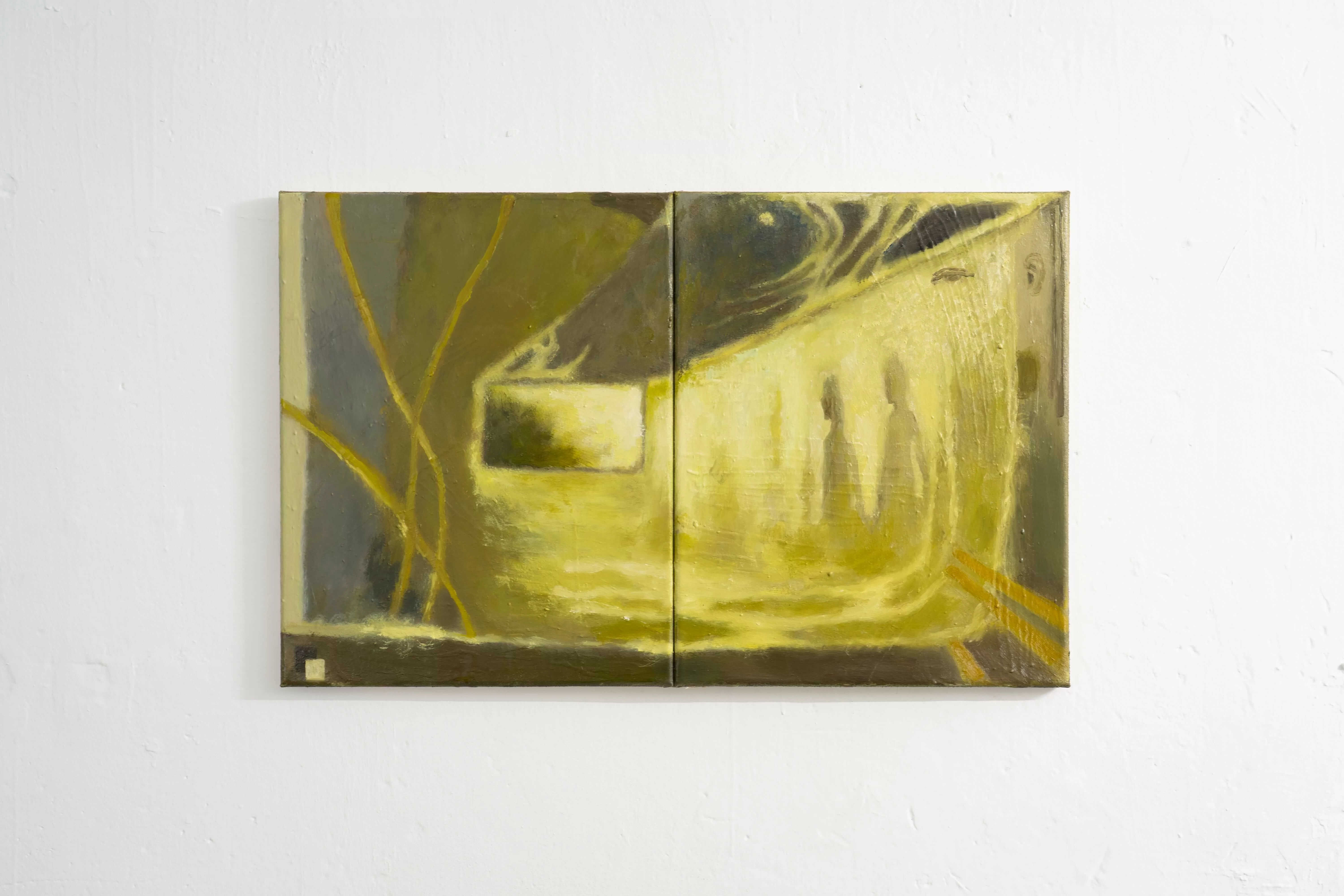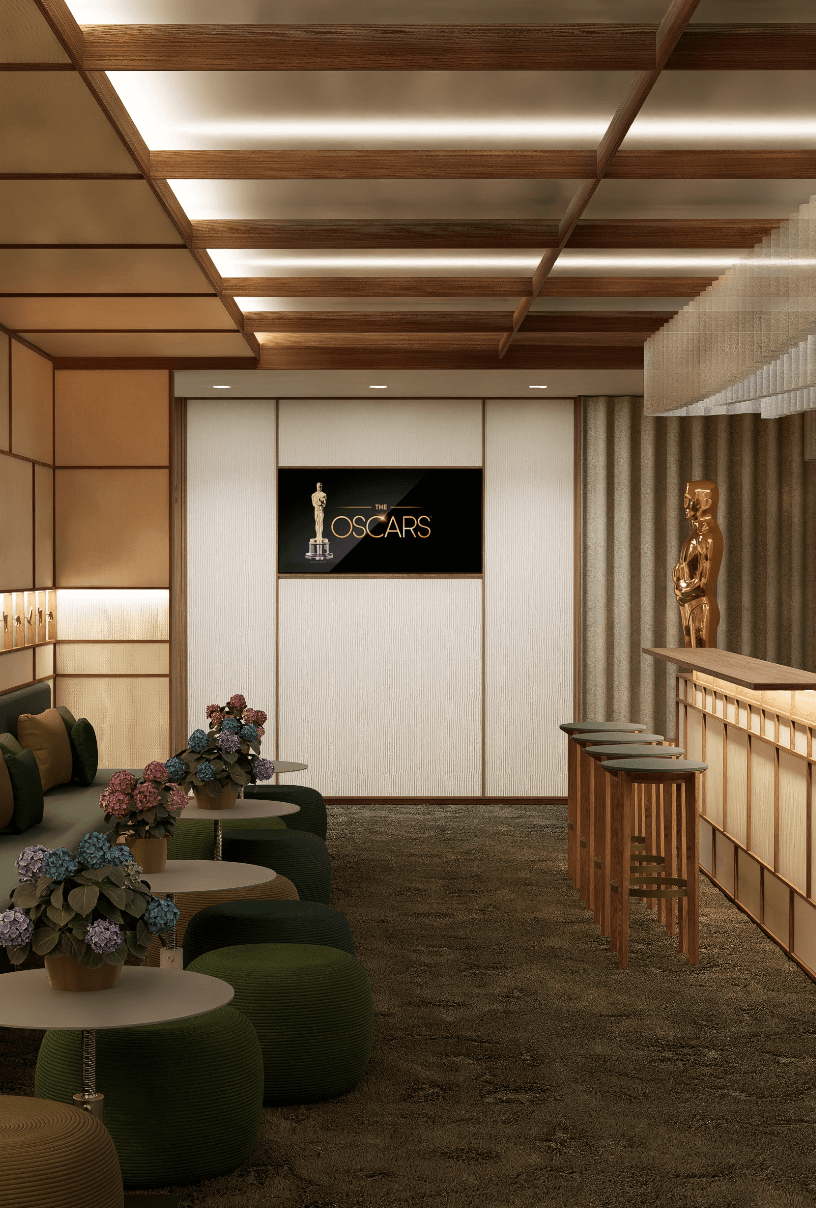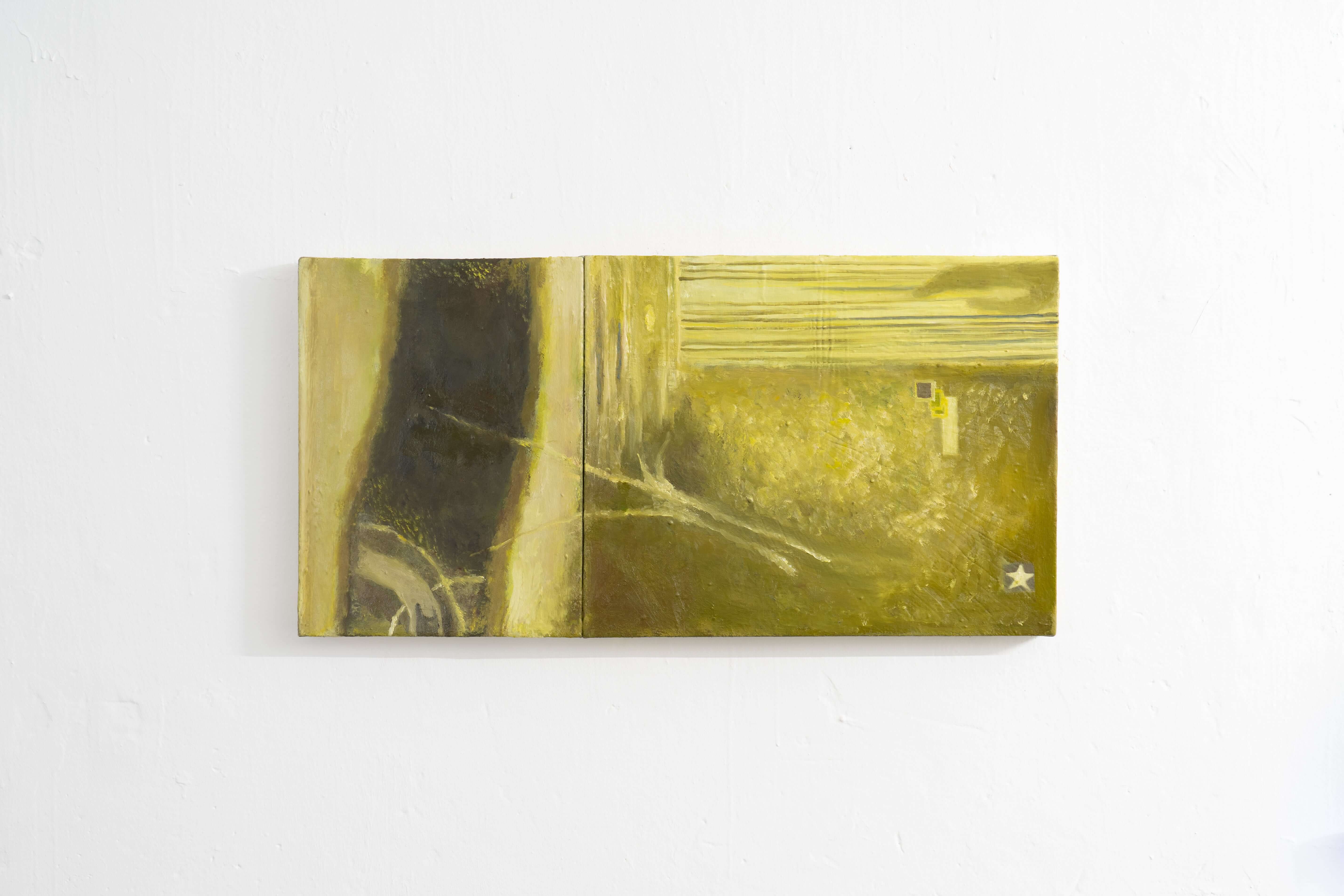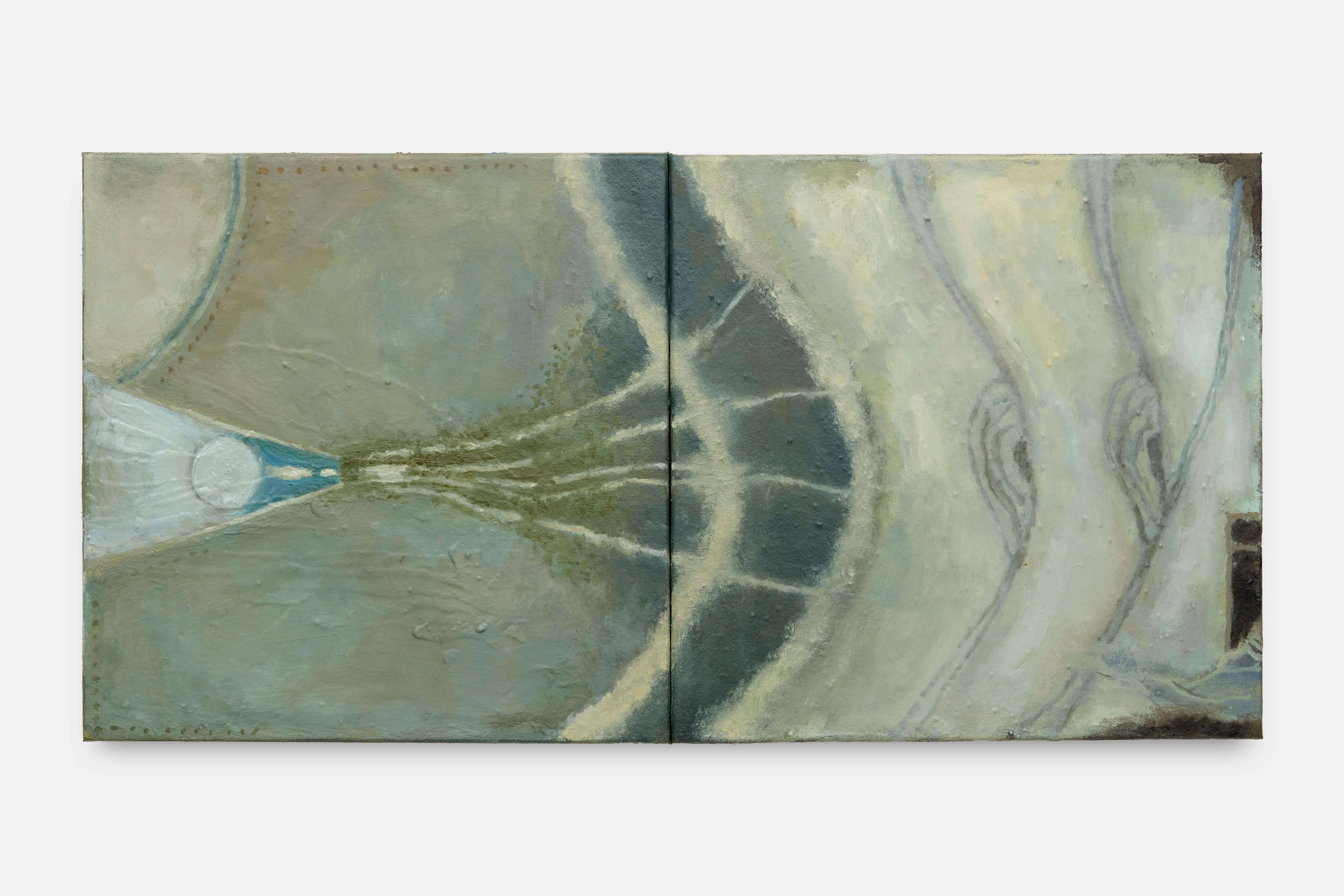(Scroll down for the English version of the interview)
PAREIDOLIA,空想性錯視,一種心理現象,意指大腦對外界的現象賦予意義,但這只是個巧合,事實上「意義」並不存在。人常把雲、石頭、樹木等看成人臉、動物、物品,像象型石、月球表面上出現的人臉、倒播音樂時聽到的「隱藏訊息」,都屬於空想性錯視帶來的幻覺。面對混沌而隨機的現實,人自然尋找線索、規則、圖象,於是現實好像有了實體。但我們又如何得知這個「現實」,是否只是人類生物腦部構造下所顯現的某種呈現方式?「現實」或許只是人類共享的一個某個維度下的「介面」,而由此推論,世界上可能存在超越人類理解的現象。對藝術家陶伊來說,人就好像一個「暫時顯現、終將消逝的信息庫」。
甫走進黃竹坑 PODIUM 藝廊的群展「業縫」,陶伊或深或淺、土黃色調的畫作,與門窗外透進空間的光線融合,令畫面呈現浮動著的狀態。畫作的大小相若但不一,各約長 80 餘厘米。然而油彩繪畫出來的畫面時而平坦、時而深邃,一些幾何及有機的形態在畫面的非中心位置出現,既像電路板,又像血管,有時可見一隻清晰可辨的手或耳朵 — 恍如漣漪般由一個畫面延展至另一個畫面,彷彿在暗示一些超越畫面以外的東西。對藝術家來說,她整個創作是一個拼圖遊戲,或「繁衍中的胚胎」,微觀和宏觀只是角度的問題。但藝術家並不只在製造幻象,畫作上顏料的厚度和質感清晰可見,又指明著畫作血肉般的存在,彷彿一個人與幻象接觸的介面。
陶伊指,她一直著迷生死衰老循環的大問題,這個展覽亦促使她思考量子力學,以及佛學中無常等概念。前者發現當科學家嘗試在著名的雙縫實驗(DOUBLE-SLIT EXPERIMENT)中標記光粒子的走向時,干涉現象便告消失,意即觀察的這種行為,改變了物質的狀態,物質特性的呈現全在乎人如何觀察它。而量子糾纏、疊加等現象的發現,亦暗示著這些非常理能理解的現象,可能反映著超自然現象的可能性;在佛教的核心概念中亦強調,當試圖用言語去描述事物時,就會改變了事物的本質,兩者都在趨近著一個不可思慮言說的境界:越是嘗試捕捉實相,實相反而越逃越遠。在當代科技控制(CYBERNETICS)人體的時代,人與機械的欲望分野越來越模糊。藝術家似乎有試圖思考這些終極問題的野心,但是她沒有採用說教的方式去呈現,而是考慮材料的物質性 — 筆觸既縝密又化開,顏料疊加的厚度、形象和現成物的配置,仔細地控制著畫面的平衡、觀眾的視線及與作品之間的距離,控制著感受和意識的衍生和製造的過程,指引著一些畫面以外的幻象。

YI TO, ‘ROMANTIC PLASTIC’, 2024, 61 X 61 CM, OIL ON CANVAS. PHOTO: LOK HANG WU. COURTESY OF THE ARTIST AND PODIUM, HONG KONG.
你在工作室的一天通常是怎樣的?
我通常會在中午左右到達工作室,然後一直待到深夜。大多數時候,我會先開始靜觀作品,直到我感覺是時候拿起畫筆開始做事。然後我會一直畫至我感覺身體與精神上無法再給予為止。很多時候,我感覺自己是在挖掘畫面已潛在的線索,而不是在建立一個作品。
你是如何創作一件畫作的?有什麼特定的模式嗎?
在使用底劑和大理石粉的混合物為畫布打底後,我通常會先根據我想要的畫面溫度來決定顏色,然後再開始使用比較薄的油畫顏料逐層堆疊。堆疊過程中,我會開始在自然流動的顏料找尋潛在的結構和線索:他們通常都較擬人化。畫面結構對我而言像是人體的代母,而且會逐漸脫離肉體。線索可以是一隻耳朵、一雙眼睛或一隻看起來像指針的手——他們出現後便會自己引導和改變構圖,就像它們真的有自己的想法一樣。
你的創作靈感來自哪裡?有沒有特別欣賞的藝術家、作家、電影或音樂人?
在個人層面上,我主要是透過日常觀察去發現生活中較小和較大單位之間的視覺連結。我認為我其實是在嘗試捕捉作為一個人在此時此地存在的感覺。在日常輪迴這模式底下活著,我更傾向將人類視為一種物質與非物質的運動、圖騰和網狀系統。
近年來我較被有懸念、肌理、觀念卻保留人性化的作品所吸引。對我有啟蒙作用的藝術家有很多,而 DORIS SALCEDO、TISHAN HSU、GRAHAM SUTHERLAND、ALINA SZAPOCZNIKOW 和 AMBERA WELLMANN 的作品最近對我影響較大。
對比起視覺層面,其實聲音對我的創作可能影響更為深遠。由於我大部分時間都在工作室裡獨自創作,所以我花頗多心思去選擇和安排我每天聽的內容。 60 年代末到 90 年代西方電子音樂發展對我影響尤其巨大 —— 近年我一直在循環播放 TANGERINE DREAM、EDGAR FROESE、KLAUS SCHULZE、RAY LYNCH、JUN FUKAMACHI、SEIJI YOKOYAMA、CYRILLE VERDEAUX 和 MIKE BROOKS (UK)。我發現這類聲音為我提供了一種實驗性視角來處理畫面潛在的電影感、敘事手法、幾何和非線性現象——這完全改變了我處理視覺訊息的方式。

YI TO, ‘A PURPOSEFUL ARRANGEMENT OF PARTS’, 2024, 40 X 80 CM, OIL ON CANVAS. PHOTO: LOK HANG WU. COURTESY OF THE ARTIST AND PODIUM, HONG KONG.
你的作品經常使用柔和的粉色調,而你今年在 PODIUM GALLERY 展出的作品則是以啡黃調為主。選用這些色彩背後有特別想法嗎?
由於我們比較熟悉土系的色調,所以啡黃色對我來說是一個畫面的入口。我很常思考「熟悉」和「陌生」這兩個概念,並發現很多時候我會無意識地著迷於想要讓熟悉的顏色變得古怪,或是讓紫色這種少在自然界出現的顏色變得易親近。我想尋找二元的結合和隨之而帶來的曖昧狀態。
你今年在 PODIUM GALLERY 展出的作品與量子力學有關。你是如何將這個主題融入你的創作的?
其實我對量子物理學一無所知,更不確定它可以物質方式如繪畫表達得到。儘管如此,大家確實知道量子世界中有許多尚未解釋的奇怪現象,很多都對我來說奇妙地觸及到超心理學(PARAPSYCHOLOGICAL)的範疇。以此為出發點,或許我們可以在繪畫中以因果關係和非線性等方式找到共鳴。其實科學對我而言一直是一個哲學議題,由其是現在我們已經在一定程度上了解量子糾纏以及隨之而來「不能說」的層面:就像當我們越努力想去確切知道雙縫實驗中物質的去向,我們就似乎距離真相愈遠。這似乎為我們到底在此網狀系統中是誰和是什麼的本質問題提供了一點線索。
在你的創作中,人體、機械和抽象元素自然融合於一個平面之中,這些抽象和具象的造型是如何構想出來的?你對人體、科技和科學之間的關係有什麼想法?
我作品中許多人體的來源其實都純粹來自我有幻想性錯覺的傾向 ( PAREIDOLIA ),所以我會在一盤混沌的資訊中找出人臉、肉體和有意義的圖像——這由其對我在剛開始一幅畫的早期階段找到熟悉感很有幫助。在其餘時間我會以解構方底來決定構圖,比如我會以幾何圖案去打底,然後透過把中心移位來破壞平衡藉此嘗試找到張力,此後畫面上所有資訊都會因應移位重新校準。
漸漸地我發現自己對身體的內部比外部的肉體和皮膚更感興趣,所以在過去的兩年間,我花了頗多時間去查看醫學影像以探索我們的內部結構,比如說超音波掃描圖、細胞圖和骨骼結構等。我對微觀世界著迷的其中一個原因是體內與體外大型結構有很多相似之處——對我而言我們就是一塊行走的電路板,反之亦然。每當我在飛機起飛時向窗外看,見證建築物慢慢縮小並變得像血管時亦有同樣的感覺。
科技為我們提供了另類想像和理解人體的方法—同樣,在我的作品中,我嘗試在不使用太多身體的情況下想像身體的存在感。
YI TO, ‘FOUR LEGS GOOD, TWO LEGS BAD’, 2023, 30 X 35 X 100 CM, TV AERIAL, SILICONE, EPOXY CLAY, ACRYLIC, ALUMINIUM WIRE. COURTESY OF THE ARTIST AND ALICE AMATI
你的作品中有種幻象般的感覺,畫面有時較平面,有時具深度,當中的形態彷佛延伸到畫框外。你對幻象(或現實)有什麼理解?
我花很多時間思考存在本身這大議題,研究意識上的異境和生活中特殊又怪異的細節:這似乎能幫助我在這似虛似幻的現實紮根。久而久之,我發現這種曖昧狀態才讓我感到踏實。當一件事越超現實,對我來說就越真實。
自小我便意識到生命的循環,以及隨之而來的徒勞、快樂和痛苦。在後來成長過程中,這感覺在佛教關於無常和無我教義中找到共鳴。認知心理學家唐納德·霍夫曼(DONALD HOFFMAN)在他的《不實在的現實》( THE CASE AGAINST REALITY ) 一書中對現實的描述非常有趣:與大眾想法相反,他認為進化史並沒有將人類與現實的本來面貌拉近——我們單純是共享同一個介面(現實)的用戶,以此推斷很有可能在這層面以外有超越人類理解的現象。如此類推,這肉眼可見的現實很有可能單純只是一個更大維度世界的陰影,就像我們現在看到的陰影只是由 3D 物體投射的現象一樣,而非現實的原型。
你的作品名稱都很有趣,是如何構思的?
我有寫下讓我產生共鳴的短語或單詞的習慣:他們可能源於一本書、一部電影、一場講課,甚至可以是使用說明書的一部分。在機緣巧合情況下,我有時亦會以我長期循環播放的一張唱片或一首音樂的名稱為我的作品命名 —— 通常這是我完成作品的最後一步。
你的創作包含繪畫和雕塑。製作時有何不同?你視這些媒介為一個整體,還是分開的?
我的畫作與雕塑是一個有骨有肉的軀體。野口勇 ( ISAMU NOGUCHI ) 將日本花園中的石頭形容成為結構中的脊梁:我對此很有共鳴。話雖如此,兩者在技術上確實有很大差異。繪畫時,對我來說最大的限制在於顏料需要時間乾透才能進行堆疊,而雕塑則更多受到物理和化學定律的限制。雖然兩者都具獨有的挑戰性,我更偏向認為完成雕塑要費力得多。而我會使用「現成物」( READYMADE )的原因是他們很自然地散發一種非常怪異的時間感,而且會自然地與繪畫對話。
你出生及成長於香港,後來遷居倫敦。這種背景對你的創作理念或實踐有影響嗎?
我在香港出生長大,搬遷到倫敦確實讓我大開眼界。在香港成長過程中,我並未有過過毋需參與考試來獲得認同感的經歷。以前我亦從未有機會如此近距離地接觸藝術,所以當時一到埗倫敦便感覺自己彷彿有一股被壓制的能量想要釋放。話雖如此,我發覺當我與香港的距離愈遠,我反而花更多時間思考中華文化和自己的身分認同。
你認為在香港和在英國展出作品感覺有分別嗎?
並無太大差別。
你最近有什麼特別關注的主題或想法嗎?
過去幾年我花較多時間內觀人體,而我亦會繼續發掘這方面的視覺語言。由於人類的存在以我理解一直是形而下和形而上的結晶,所以以內向形式去描繪人體外部變得越來越有趣和具挑戰性,而對我而言這亦比單純直接描繪外部要難得多。另外,我亦在思考如何將繪畫想像成像造字用的象形系統,比如將其中較小的意義單元組合在一起組成大一點的結構去組成字義。

YI TO, ‘DOUBLE-QUASAR’, 2024, CEMENT AND STEEL 40 X 80 CM. PHOTO: TOM CARTER. COURTESY OF THE ARTIST AND ALICE AMATI
What does a typical day in your studio look like?
I usually get to the studio around midday and stay until late night. Most of the time, I start working by staring into the works and waiting until I feel it’s time to pick up the brushes. Then I push until I feel physically can’t give anymore. Often, it feels to me more as if I’m there to excavate what’s already there than to create.
Can you walk us through your process of working on a painting? Is there a particular pattern you tend to follow?
Having primed my canvas with a mixture of gesso and marble dust, I usually land on a few colours based on the sort of temperature that I want in a painting – it’s followed by lots of layering of thin paint. In the meantime, I look for emerging structures and cues, quite often anthropomorphically. The structural elements then become surrogates for the bodies and tend to disembody eventually. It could be an ear, a pair of eyes or a hand looking as if it’s a pointer – they start guiding and shifting the composition themselves as if they have a mind of their own.
Where do you find inspiration for your work? Are there any artists, writers, films, or musicians that influence you?
On a personal level, It’s mostly just through daily observation where I find visual connections between the smaller and bigger units of life. I like to think I’m trying to catch what it’s like to exist as a human in the here and now. Having lived through this repetitive everydayness, I tend to see humans as movement, patterns and networks.
At this point, I find myself more attracted to works that are psychological, textured, conceptual but somatic. The list changes all the time but I’ve felt a deep affinity for the work by Doris Salcedo, Tishan Hsu, Graham Sutherland, Alina Szapocznikow and Ambera Wellmann over the past few years.
That said, it’s fair to say I might be more influenced by sounds than visual cues because I spend most of my time by myself in the studio and really try to be thoughtful in curating what I listen to on a daily basis. Music produced between late 60s and 90s in relation to psychedelia particularly has made a huge impact on me – I put Tangerine Dream, Edgar Froese, Klaus Schulze, Ray Lynch, Jun Fukamachi, Seiji Yokoyama, Cyrille Verdeaux and Mike Brooks (UK) on loop. I find that sounds of that kind have offered me a new and experimental perspective into cinematicity, narratives, geometry and nonlinearity – that has shifted the way I process visual information.
Your paintings feature a palette of pastel colors, while the pieces you exhibited at the Podium Gallery this year were predominantly in earthy brown hues. Is there a reason behind your choice of this color scheme?
Earthbound palette to me serves somewhat as an entrance. I contemplate upon familiarity and unfamiliarity – quite often, I become unconsciously obsessed with making a familiar colour outlandish and an unfamiliar colour like purple, intimate. It’s almost always about the alchemical marriage between two opposites and bringing about the ambiguity that comes with it.
The paintings you exhibited at Podium Gallery this year relate to quantum physics. How do you connect your work and practice to the subject matter?
It’d be unfair of me if I say I know anything about quantum physics and that it can be painted at all. Though I do know there are many strange phenomena in the quantum world that are yet unexplained which are to me somewhat parapsychological, and I suppose parallels can be drawn in paintings when one gets to play with causality and nonlinearity. Deep down I feel it’s always about the big questions in life especially now that we’ve learnt about quantum entanglement to a certain extent and the unspeakability that comes with it, as in the harder we try to see what actually happens through a double slit, the more we’re veiled from it. How that relates to the network humans exist in offers insight into the nature of who and what we are.
In your artwork, human forms, machines, and abstract elements seamlessly blend together on the same plane. How do you decide on the shapes and forms you use? How do you understand the relationship between the human body, technology and science?
A lot of the somatic forms in my works are purely based upon my pareidolic tendency that has served me well in finding familiarity in the earlier stages of painting where I would look for faces and body parts in a pool of random information. Other times, I land on a composition through deconstruction where I would start implementing geometry only to destroy it by pulling the centre away to find tension and everything else will recalibrate.
Gradually I find myself more drawn to the interior of the body than just flesh and skin that we’re most familiar with so I’ve spent a lot of time over the past two years navigating our internal structures by looking through medical images including ultrasound scan, cellular biology, bone structures and the like. It is fascinating to me that the human body when looked at microscopically bears lots of resemblance to the larger structure in life as if we are a walking circuit board, and vice versa – I get the same feeling every time I look out of the window when the plane takes off where buildings slowly zoom out and become vascular.
Technology has given us means to visualise and understand the body beyond the flesh – likewise in my work I try to play around the idea of creating a presence of the body without using much of the body.

YI TO, ‘TOMORROW IS YESTERDAY’, 2024, 50 X 80 CM, OIL ON CANVAS. PHOTO: LOK HANG WU. COURTESY OF THE ARTIST AND PODIUM, HONG KONG
Your works often have an illusionistic quality, with the compositions sometimes appearing flat and at other times suggesting depth, and the forms seeming to extend beyond the frame. How do you understand the concept of illusion (or reality)?
I spend a lot of time pondering upon the big questions in life, researching altered states of consciousness and the weird particulars in life because these somewhat help me ground myself in the here and now when reality seems to be weirder than we can suppose. Over time, ambiguity serves as clarity and the more unreal it becomes, the more real it seems to me.
From a young age, I was conscious of the cycles of life, the futility, pleasure and pain that apparently come with them. Later in life, I find the parallels in Buddhist teaching in relation to impermanence and the illusion of the self. It is perhaps true of what cognitive psychologist Donald Hoffman explains in his book ‘The Case Against Reality’ where in contrary to what we have been taught to believe, evolution has not helped human species see and understand reality in its actual form – we’re users sharing the same interface and that there is something beyond. I also like to think of this dimension of reality as the shadows of another dimensionally bigger world just as how the shadows we see now are simply cast by 3D objects.
Your works have interesting titles. How did you come up with them?
I write down interesting phrases or words that I resonate with whenever I come across them – it could be a part of a book, a film, a lecture or even a user manual. Other times, it might be the title of a record or a piece of music that I’ve put on loop if emotionally it feels right. I don’t consider a piece of work finished without giving it closure with an appropriate title.
Your body of work includes both paintings and sculptures that incorporate found objects. Does your approach differ when working with these two different mediums? Do you consider these mediums as a unified whole or as separate elements?
I look at my paintings and sculptures as if they’re a body of flesh and bones. Noguchi describes the stones in Japanese Gardens as backbones and I resonate deeply with that. That said, it is indeed true that both of them are very different in the making in terms of technicality. When I paint, I’m mostly restricted by the time it takes for the layers to dry before I can lay my hands on them again whereas sculptures are more restricted by laws of physics and chemistry. Both are challenging in their own ways but I’d say making sculptures is a lot more laborious. I like the idea of found objects because they naturally give a very strange sense of time and always crosstalk with the paintings.
You were born in Hong Kong and later moved to London. Does this background influence your ideas or creative practice in any way?
I was born and raised in Hong Kong – moving to London has definitely opened my eyes and never in my life did I not have to sit in exams to try to achieve or prove anything. I’ve also never had access to so much art in my life so I felt as if I’d carried this explosion of energy that I wanted to let out as soon as I set foot in London. That being said, I’ve realised that the farther away I am from where my hometown is, the more curious I am about my own culture and identity.
Have you noticed any differences in how your work is received or presented in Hong Kong compared to the UK?
I haven’t noticed a major difference.
Are there any particular thoughts or concepts that you have been focusing on recently?
I’ve spent the past few years researching the interior of the bodies and will continue to expand on that. It has become increasingly more interesting for me to find ways to portray the human body without apparently utilising the surface level of the appearance because human existence to me has always been both physical and metaphysical. To add to this, I’d also like to play around the idea of building my work like a pictorial system of written characters where smaller units of meaning are put together into bigger units to create and manipulate meanings.

YI TO, ‘TOMORROW IS YESTERDAY’, 2023, 100 X 130 CM, OIL ON CANVAS. PHOTO: TOM CARTER. COURTESY OF THE ARTIST AND ALICE AMATI
















Comments